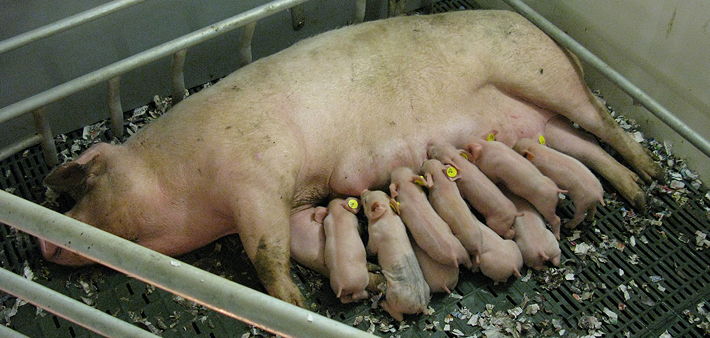Sow productivity continues to limit the competitiveness of GB pig production, according to a new report from InterPIG.
While the number of pigs weaned per sow per year increased at the same rate as the EU as a whole (+2%) in 2016, at 24.83, the figure was well behind the EU average. Even the figure for GB indoor production, 26.2, remained below the EU average. British productivity continues to be limited by the number of pigs born alive per litter, which averaged 13.8 in the EU, but only 12.5 in GB (indoor sows 13, outdoor sows 11.7).
Denmark achieved 32 pigs weaned/sow/year, followed by Belgium and the Netherlands at around the 30 mark.
Great Britain was the only member country to record a decline in pig production costs in sterling terms last year, according to the report. The InterPIG group consists of a selection of organisations from key producing countries, with AHDB representing GB.
The improvement in the relative cost of British pig production was primarily due to the significant devaluation of the pound following the Brexit vote last June. The annual average value of sterling against the euro was 11% lower than year earlier levels, making production costs in EU countries comparatively higher. As such, GB fell from the second costliest producer in the InterPIG group in 2015, to sixth place in 2016. GB production costs remained the second highest if the currency effect is removed.

Relative feed prices were particularly affected by the devaluation of the pound. In sterling terms, all countries apart from GB recorded an increase in the cost of feed, with the EU average cost per kg increasing 4% on the year. Conversely, the GB cost per kg declined 7%.
While the cost of production of other countries increased compared to Britain, in fact almost all member countries would have felt a decline in production costs in their native currency, compared to 2015. In euro terms, the EU average cost of production declined 4% year-on-year. This was partly driven by a decline in the EU average feed cost per kg in euros, though physical performance also improved. The number of pigs weaned per sow per year in the European InterPIG countries showed a 2% increase in 2016, reaching 27.53.
Looking forwards, further weakening of the currency for 2017 may translate into an additional boost for GB competitiveness next year, although this could be somewhat limited by rising domestic feed costs. In the longer term, however, British producers will need to focus on improving physical performance to boost competitiveness sustainably. This may be especially pertinent post-Brexit, when there is the possibility of having to compete more directly with US and Brazilian product on the domestic market, depending on the import tariffs adopted by the government. Both of these countries have considerably lower production costs.




